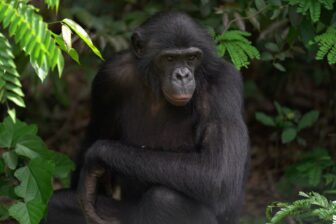It’s more than sex.
By Jeni Smithson
What comes to mind when you think about bonobo behavior? The first few times I talked about bonobos with anyone, the conversation always started with – bonobos have a ton of sex! But sexual behavior doesn’t have to be the defining behavior in a bonobo. Bonobos, our closest living relatives, do more than just have good sex. Let’s talk about their other behaviors for a change!

Social Behavior of Bonobos
Bonobos are very social primates who live in a fission-fusion society. This means that over time, perhaps as they travel through the forest during the day, smaller subgroups split from the larger group (fission) and merge (fusion) into new temporary groups(1).
It’s like hiking with your entire family, aunts, uncles, and cousins included. You might start off trekking alongside a small group of only cousins but finish the trail with your siblings.
The bonds created between bonobos are strong and long-lasting. A mother and her offspring have the most stable bond (2), but nothing beats the bond between a mother and her son. While females leave their natal group at puberty, males will stay with their mothers for a lifetime – literally.
The bonds created between bonobos are strong and long-lasting. A mother and her offspring have the most stable bond (2), but nothing beats the bond between a mother and her son. While females leave their natal group at puberty, males will stay with their mothers for a lifetime – literally.

Bonds between a mother and her offspring are the strongest of the three main social bonds bonobos form. Female bonobos typically rear offspring every four to five years, and this time gap allows mothers to form strong bonds with their children.
Social groups of only females make up the second strongest bonds among bonobos. Unrelated females form powerful coalitions to manage male aggression. In other words, they live in a matriarchal society where females run the show. Let’s just say females don’t put up with any male BS.
It’s pretty amazing how female bonobos effortlessly accept one another, often without question. How empowering to be a female bonobo!
Bonds between females and males make up the least stable social group. A typical social interaction between the adult sexes occurs when a female wants something, often food. And when it comes to food sharing, bonobos are one of the few non-human primates willing to share with complete strangers (3).
Researchers have discovered four main grooming types: stroking hair, picking through hair, removing things by hand or lips, and scratching.
Grooming is a friendly social behavior that occurs in relaxed and peaceful conditions. Honestly, when has a good back scratch ever been unrelaxing? Researchers have discovered four main grooming types: stroking hair, picking through hair, removing things by hand or lips, and scratching (4).

In the wild, it’s common to see a gathering of numerous dyads (groups consisting of two individuals) all engaged in a grooming session. Once again, females tend to stick together and groom each other, strengthening the matriarchal society.
Males and females do groom one another, and males often groom other males. Research has shown that grooming sessions among males last for more extended periods compared to female grooming sessions (4).
Play Behavior in Bonobos
It’s no secret that play is crucial in the healthy development of human and non-human primates (5). But for bonobos, playful behavior continues long into adulthood, making them possibly the most playful non-human primates. They’ve even been called “the Peter Pan ape” because of their never-ending childlike behavior.
At Lola ya Bonobo sanctuary, bonobos have been seen rolling downhill, bouncing another bonobo on their feet in a game similar to “airplane”, chasing each other, playing “keep away,” and swinging from trees, all for fun. Along with maintaining and establishing relationships, social play builds trust, tests social roles, aids in the development of motor skills, and provides abundant exercise.

Bonobos mainly engage in social play, commonly initiated by facial displays. One study at the Apenheul Primate Park in the Netherlands found 17 different categories of play behavior in captive bonobos (2). Among them were familiar behaviors such as Airplane, Tickle, Acrobatic Play, and Pirouetting.
A social game observed in wild bonobos at Wamba is called the ‘hang game.’ It is similar to a trust-building exercise between two bonobos. An adult bonobo climbs up a tree, holds a younger bonobo by arm or leg, and swings them back and forth. The young bonobo trusts the adult not to let go of them.

Solitary play is also a bonobo pastime. At the Wamba field study site in DR Congo, water play is one solitary game that wild bonobos engage in. Trailing hands and feet through still water and observing the effects offers a sense of exploration of the different elements of water when disturbed. (6).
As highly social primates, playful behavior in bonobos is extremely interconnected (6), meaning that play is not limited to sex or age. Some examples of group play among bonobos include two female adults, an adult female and a subadult female, an adult male and juvenile or adolescent males, juvenile males playing with adult females, and so on.

Communication Among Bonobos
Bonobos do not hold back when they have something to say! In fact, they are incredibly communicative great apes who use “multimodal signaling,” meaning combinations of vocalizations, facial expressions, and gestures. Vocal messages can travel long or short distances, likely occurring in synchronized choruses that sound like echoes (7).
One of the biggest things that set apes apart from monkeys is their ability to perform hand gestures. Freehand gestures are displays of ritual movement, often exaggerated, and are tied to specific contexts (8).

A familiar hand gesture found in wild and captive bonobos is a multimodal signal consisting of three movements: Bent Wrist, Begging, and Arm Up.
When in motion, one arm’s wrist is flexed, the other arm is in a lateral position, and the hand displays an upward-facing palm. The behavior of these gestures suggests that an individual is begging for food from another individual and wants to make contact with them.
Bonobos are wonderful at communicating their emotions through facial expressions. Because of their frequent eye contact, it is easy to monitor facial cues closely (9).

The meaning of silent teeth-baring isn’t always easy to interpret and depends on the context. A range of emotions can motivate a bonobo to retract their lips and expose their teeth and gums while the mouth is closed. Sometimes it means the bonobo is expressing fear or nervousness. Other times silently barring teeth results from excitement over food or a new object. Leading primatologist Frans de Waal observed the silent teeth-baring expression displayed by a female bonobo who was happily pirouetting in a freshly built nest (9).
Now you try – retract your lips and bare your teeth. Can you cycle through a range of emotions and find a few that complement this facial expression?
As kids, we think that all apes are monkeys who say “oo-oo” “ahh-ahh,” and that concept is so misleading! Bonobos are great apes, not monkeys, and they communicate through 12 principle call types, including a range of hoots, peeps, barks, grunts, pant laughs, pout moans, and screams. Their vocalizations are generally higher pitched compared to chimpanzees. And bonobos are most vocal during copulation, eating, and responding to danger or stressful situations (7).
Screams are the most intense vocal display (9). Almost all types of screams are in response to stressful situations, such as physical aggression. However, the rasp scream denotes social attraction and sexual excitement (9).
The most adorable vocalization is, quite possibly, the panting laugh. Every day at Lola ya Bonobo Sanctuary, you can hear young bonobos in the nursery laughing. Like humans, bonobos are ticklish and can not hold back a deep laugh when being tickled. Subordinate playmates usually give panting laughs, often during playful romps such as wrestling. Laughter is not limited to baby and juvenile bonobos; adults laugh too. I believe I can speak for all when I say life would be miserable without laughter!
Sources:
- Couzin, I. D. (2006). Behavioral Ecology: Social Organization in Fission–Fusion Societies. Current Biology , 16(5), R169–R171. https://doi.org/10.1016/j.cub.2006.02.042.
- San Diego Zoo Wildlife Alliance. (2023, May 16). Bonobo (Pan paniscus) Fact Sheet: Behavior & Ecology . San Diego Zoo Wildlife Alliance Library. https://ielc.libguides.com/sdzg/factsheets/bonobo/behavior
- De Waal, F. (1997). Bonobo The Forgotten Ape. University of California Press.
- Sakamaki, T. (2013). Social grooming among wild bonobos (Pan paniscus) at Wamba in the Luo Scientific Reserve, DR Congo, with special reference to the formation of grooming gatherings. Primates, 54, 349–359. https://link.springer.com/article/10.1007/s10329-013-0354-6#Sec15.
- Furuichi, T., & Thompson, J. (2008). The Bonobos Behavior, Ecology, and Conservation . Springer.
- Behncke, I. (2015). Play in the Peter Pan ape. Current Biology , 25(1), R24–R27. https://doi.org/https://doi.org/10.1016/j.cub.2014.11.020
- Lacambra, C., Thompson, J., Furuichi, T., Vervaecke, H., & Stevens, J. (2005). Bonobo (Pan paniscus). In World Atlas Of Great Apes And Their Conservation (pp. 83–96). University of California Press.
- Pollick, Amy S, Annette Jeneson, and Frans B.M. de Waal. “Gestures and Multimodal Signaling in Bonobos .” The Bonobos. Developments in Primatology: Progress and Prospects . New York, NY: Springer, 2008. 75–94. https://doi.org/10.1007/978-0-387-74787-3_5.
- De Waal, Frans B. M. “The Communicative Repertoire of Captive Bonobos (Pan Paniscus), Compared to That of Chimpanzees.” Behaviour, vol. 106, no. 3/4, Sept. 1988, p. 183–251, Brill, doi: https://www.jstor.org/stable/4534707.
- ******
Jenni Smithson is a student at NC State University who worked with Friends of Bonobos as a summer intern in 2023.


 Kendra is a creative problem-solver who provides executive and operational support across the organization. As Executive Assistant to Ariel Rogers, she manages scheduling, communications, and day-to-day priorities while also supporting the development and communications teams with administrative and operational needs.
Kendra is a creative problem-solver who provides executive and operational support across the organization. As Executive Assistant to Ariel Rogers, she manages scheduling, communications, and day-to-day priorities while also supporting the development and communications teams with administrative and operational needs. Kathleen Cook brings more than nine years of experience working across Africa, with a focus on the Democratic Republic of Congo, where she has traveled over twenty times to support projects spanning conservation, clean energy, and community development. Her career has centered around using storytelling, strategic marketing, and relationship-building to create meaningful impact.
Kathleen Cook brings more than nine years of experience working across Africa, with a focus on the Democratic Republic of Congo, where she has traveled over twenty times to support projects spanning conservation, clean energy, and community development. Her career has centered around using storytelling, strategic marketing, and relationship-building to create meaningful impact.
